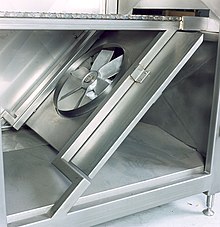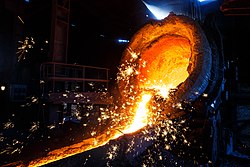
Back Vlekvrye staal Afrikaans فولاذ مقاوم للصدأ Arabic Aceru inoxidable AST Paslanmaz polad Azerbaijani پاسلانماز پولاد AZB Нержавеючая сталь Byelorussian Неръждаема стомана Bulgarian Waja tahan tagar BJN মরিচাবিহীন ইস্পাত Bengali/Bangla Nehrđajući čelik BS


| Steels |
|---|
 |
| Phases |
| Microstructures |
| Classes |
| Other iron-based materials |
Stainless steel, also known as inox, corrosion-resistant steel (CRES) and rustless steel, is an alloy of iron that is resistant to rusting and corrosion. It contains iron with chromium and other elements such as molybdenum, carbon, nickel and nitrogen depending on its specific use and cost. Stainless steel's resistance to corrosion results from the 10.5%, or more, chromium content which forms a passive film that can protect the material and self-heal in the presence of oxygen.[1]: 3
The alloy's properties, such as luster and resistance to corrosion, are useful in many applications. Stainless steel can be rolled into sheets, plates, bars, wire, and tubing. These can be used in cookware, cutlery, surgical instruments, major appliances, vehicles, construction material in large buildings, industrial equipment (e.g., in paper mills, chemical plants, water treatment), and storage tanks and tankers for chemicals and food products.
The biological cleanability of stainless steel is superior to both aluminium and copper, and comparable to glass.[2] Its cleanability, strength, and corrosion resistance have prompted the use of stainless steel in pharmaceutical and food processing plants.[3]
Different types of stainless steel are labeled with an AISI three-digit number.[4] The ISO 15510 standard lists the chemical compositions of stainless steels of the specifications in existing ISO, ASTM, EN, JIS, and GB standards in a useful interchange table.[5]
- ^ Davis, Joseph R., ed. (1994). Stainless Steels. ASM Specialty Handbook. Materials Park, OH: ASM International. ISBN 978-0871705037. Archived from the original on 14 April 2021. Retrieved 8 March 2020.
- ^ Boulané-Petermann, L. (1996). "Processes of bioadhesion on stainless steel surfaces and cleanability: A review with special reference to the food industry". Biofouling. 10 (4): 275–300. Bibcode:1996Biofo..10..275B. doi:10.1080/08927019609386287. ISSN 0892-7014. PMID 22115182. Retrieved 21 January 2022.
- ^ Zaffora, Andrea; Di Franco, Francesco; Santamaria, Monica (October 2021). "Corrosion of stainless steel in food and pharmaceutical industry". Current Opinion in Electrochemistry. 29: Article 100760. doi:10.1016/j.coelec.2021.100760. Retrieved 21 January 2022.
- ^ ASM International (2000). "Introduction to Stainless Steels". Alloy Digest Sourcebook: Stainless Steels. Archived from the original on 1 July 2021. Retrieved 1 October 2021.
- ^ International Organization for Standardization (May 2014). "ISO 15510:2014 Stainless steels – Chemical composition". Archived from the original on 2 June 2021. Retrieved 1 October 2021.
© MMXXIII Rich X Search. We shall prevail. All rights reserved. Rich X Search